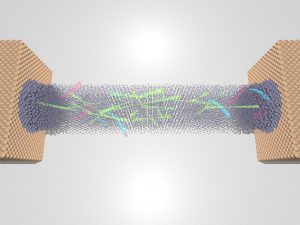Pair-breaking quantum phase transition in superconducting nanowires
 Quantum phase transitions (QPT) between distinct ground states of matter are widespread phenomena, yet there are only a few experimentally accessible systems where the microscopic mechanism of the transition can be tested and understood. These cases are unique and form the experimentally established foundation for our understanding of quantum critical phenomena. Here we report that a magnetic-field-driven QPT in superconducting nanowires—a prototypical one-dimensional system (d=1)—can be fully explained by the critical theory of pair-breaking transitions characterized by a correlation length exponent v≈1 and dynamic critical exponent z≈2. We find that in the quantum critical regime, the electrical conductivity is in agreement with a theoretically predicted scaling function and, moreover, that the theory quantitatively describes the dependence of conductivity on the critical temperature, field magnitude and orientation, nanowire cross-sectional area, and microscopic parameters of the nanowire material. At the critical field, the conductivity follows a T(d–2)/z dependence predicted by phenomenological scaling theories and more recently obtained within a holographic framework. Our work uncovers the microscopic processes governing the transition: the pair-breaking effect of the magnetic field on interacting Cooper pairs overdamped by their coupling to electronic degrees of freedom. It also reveals the universal character of continuous quantum phase transitions.
Quantum phase transitions (QPT) between distinct ground states of matter are widespread phenomena, yet there are only a few experimentally accessible systems where the microscopic mechanism of the transition can be tested and understood. These cases are unique and form the experimentally established foundation for our understanding of quantum critical phenomena. Here we report that a magnetic-field-driven QPT in superconducting nanowires—a prototypical one-dimensional system (d=1)—can be fully explained by the critical theory of pair-breaking transitions characterized by a correlation length exponent v≈1 and dynamic critical exponent z≈2. We find that in the quantum critical regime, the electrical conductivity is in agreement with a theoretically predicted scaling function and, moreover, that the theory quantitatively describes the dependence of conductivity on the critical temperature, field magnitude and orientation, nanowire cross-sectional area, and microscopic parameters of the nanowire material. At the critical field, the conductivity follows a T(d–2)/z dependence predicted by phenomenological scaling theories and more recently obtained within a holographic framework. Our work uncovers the microscopic processes governing the transition: the pair-breaking effect of the magnetic field on interacting Cooper pairs overdamped by their coupling to electronic degrees of freedom. It also reveals the universal character of continuous quantum phase transitions.
Hyunjeong Kim, Frédéric Gay, Adrian Del Maestro, Benjamin Sacépé, Andrey Rogachev. Nature Physics (2018)
